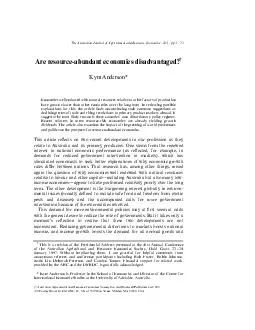

In reviewing possible explanations for this the article 57506nds unconvincing such common suggestions as declining terms of trade and rising restrictions to primary product markets abroad It suggests the most likely reason is these countries own dis ID: 34255
Download Pdf The PPT/PDF document "Are resourceabundant economies disadvant..." is the property of its rightful owner. Permission is granted to download and print the materials on this web site for personal, non-commercial use only, and to display it on your personal computer provided you do not modify the materials and that you retain all copyright notices contained in the materials. By downloading content from our website, you accept the terms of this agreement.
includingacleanenvironment.Ifacleanerenvironmentisnotonlyanormalgoodbutasuperiorone(inthesensethatitsincomeelasticityofdemandexceedsunity),allthemorereasontoexpectincomegrowthtogeneratedemandsforbetterenvironmentaloutcomes.Furthermore,ifreducinggovernment-inducedwastageimprovesthee¤ciencyofresourceuse,thatisconsistentwithmoreenvironmentalconsciousness.Thereis,however,arealriskthatheavy-handedorotherwiseinappropriateenviron-mentalpolicyresponsescouldunderminethegainsfromothereconomicreformsöandevenbeenvironmentallycounter-productive.Importantaspectsofbothdevelopmentsöthedemandforbettereconomicperformanceparticularlythroughreducinggovernmentactivitiesandregulations,andthedemandforgovernmentinitiativestobetterprotecttheenvironmentöaretheirinternationaldimensions.Inthe¢rstcase,economicrationalismhascontributedtolarge-scaleliberalisationsoftradeingoods,services,¢nancialcapitalandtechnologiesinmanypartsoftheworldduringthepastdecadeorso;andinthesecondcase,wehaveheardcallsforinternationalenvironmentalagreementsandforguaranteesthatfreerinternationaltradeandinvestmentwillnotharmtheenvironment.Sincethoseinternationaldimensionsarelikelytocontinuetogrowinimportance,theyareaparticularfocusofattentioninwhatfollows.Thearticle¢rstre£ectsonwhyeconomieswellendowedwithnaturalresourcesrelativetolabourandothercapital(hereafterreferredtoas`resource-abundant'or`resource-rich'economies)havegrownslowerthanresource-poor,denselypopulatedonesoverrecentdecades.Thisissueisnottobeconfusedwiththeissueofconvergenceofpercapitaincomelevelsacrosscountries,becausehereresourcerichnessisreferringtodi¡erencesnotinaggregateabundanceofresources(andhencenotinpercapitaincomes)butratherinnationalresourceendowmentratios.Thearticlethenlooksathowthegreeningofpoliticsthataccompaniesincomegrowthisalteringpoliciesandtherebya¡ectingfutureprospectsforresource-richeconomiessuchasAustralia's.Inbothsectionsquestionsarebeingraisedasmuchasanswersgiven,buthopefullythosequestionswillstimulatenewempiricalresearchonyet-to-beresolvedissues.1.Whyhaveresource-richeconomiesgrownrelativelyslowly?Theworld'sfastestgrowingeconomiesinrecentdecadesöJapan,HongKong,Singapore,Taiwan,SouthKorea,andmorerecentlyChinaöarealldenselypopulated.Thatis,theyarepoorlyendowedwithnaturalresourcesrelativetolabour.Inparticular,theyhaveverylittleagriculturallandperworker.Bycontrast,amongtheslowest-growingofthemoreadvancedeconomiesthiscenturyhavebeenland-abundantArgentina,AustraliaandNewZealand,nottomentiontheslower-growing,land-abundant,low-2K.Anderson#AustralianAgriculturalandResourceEconomicsSocietyInc.andBlackwellPublishersLtd1998 economiesofLatinAmericaandSub-SaharanAfrica.Moregenerally,statisticallyverysigni¢cantnegativerelationshipshavebeenfoundbetweenGDPgrowthratesandindexesofcomparativeadvantageinnaturalresource-basedproducts.SachsandWarner(1995),forexample,exploreregressionrelationshipsbetweenGDPgrowthfrom1970to1989andtheratioofresource-basedexportstoGDPin1970forasampleof97developingcountries,and¢ndthelattertobeasigni¢cantexplanationoftheformer,whateverotherexogenousvariablesareincludedintheregressions.Anderson(1995a)exploresaslightlylongerperiodwithbothwealthyanddevelopingcountries,usingasacomparativeadvantageindexanestimateoffoodself-su¤ciencyratiosintheearly1980satfree-tradeprices.ThattoowashighlynegativelycorrelatedwithGDPgrowthsince1970.1Onepossibleexplanationforthisnegativerelationshipisthateasyrichesleadtosloth.Thesixteenth-centuryFrenchpoliticalphilosopher,JeanBodin(1576),assertedthat:`Menofafatandfertilesoilaremostcommonlye¡eminateandcowards;whereascontrariwiseabarrencountrymakesmentemperatebynecessity,andbyconsequencecareful,vigilant,andindustrious.'ItisnotclearhowBodinperceivedtheimpactonwomen'se¡orts,butinanycaseIsuspectdi¡erencesininherentslothfulnessperse(asdistinctfrominactivityinducedbygovernmentpoliciesthatdampenincentives)arelikelytoprovideatmostonlyaminorpartoftheexplanationforgrowthratedi¡erencesöalthoughI'mnotsurehowthatclaimcouldbetestedempirically.Anotheroften-claimedandrelatedexplanationforgrowthratedi¡erencesisculturaldeterminism.AjournalistfromtheLondonnewspaperTheTimes,whowastravellinginAsiainthemid-nineteenthcentury,reportedthatthecountryhewasinwasinhabitedbyahomogeneousraceoflazypeoplewhomhebelievedwereincapableofeverbeingindustrious.AnAustralianconsultantvisitingthesamecountryin1915,toreporttoitsgovernmentonitsworkers,wrote:MyimpressionastoyourcheaplabourwassoondisillusionedwhenIsawyourpeopleatwork.Nodoubttheyarelowlypaid,butthereturnisequallyso;toseeyourmenatworkmademefeelthatyouareaverysatis¢edeasy-goingracewhoreckontimeisnoobject.WhenIspoketosomemanagerstheyinformedmethatitwasimpossibletochangethehabitsofnationalheritage[emphasisadded].2 1SeealsoGelbandAssociates(1988)andAuty(1990),whonotethepoorperformanceofmanyoil-richdevelopingcountriessince1973.2AsquotedinBhagwati(1983),withthankstoJustinLinforbringingittomyattention.Areresource-abundanteconomiesdisadvantaged?3#AustralianAgriculturalandResourceEconomicsSocietyInc.andBlackwellPublishersLtd1998 reporterswerereferringtoJapan!Thosereports,andthefactthatitwasEuropeandnotAsiathatenjoyedthe¢rstfewcenturiesofindustrialgrowth(Jones1981),makenonsenseoftheoppositeclaimthatrapideconomicgrowthispeculiartoAsianorConfuciancultures.3Someothercommonhypothesesthataremorenarrowlyintheeconomicorpoliticaleconomyrealmsdeservemoreconsideration.One,popularisedbyPrebisch(1964)öandcontrarytothefearofMalthusiansandotherdoomsdayersöisthatresource-abundanteconomiesfacecontinualdeclineintheirtermsoftrade.Anotheristheassertionthattherearemoregrowth-inducingfactorsassociatedwithmanufacturingindustriesthanprimaryproduction.Athirdisthatresource-pooreconomieshavemorescopetogrowviatechnologicalcatch-up.Andafourthisthattheexportersofresource-abundantcountriesfacelargerprotectionistbarriersabroadthandoexportersofnon-primaryproducts.Eachoftheseisexploredinturn,afterwhichconsiderationisgiventothepossibilitythatpoliciesaremoredistortionaryinresource-abundanteconomies.1.1DeterioratingtermsoftradeThepriceofprimaryproductsrelativetomanufacturesininternationalmarketsappearstohavebeenonalong-rundeclineforacenturyormore(GrilliandYang1988).Evenwhenmoresophisticatedadjustmentsaremadetothedatatotakeintoaccountgreaterimprovementsinthequalityofmanufactures,asLipsey(1994)didrecently,thattendencyisonlyweakenedratherthanreversed.Whatexplainsthatdownwardtrend?Themostcommonlysuggestedexplanationisthatthedemandforprimaryproducts,particularlyfoodatthefarm-gatelevel,isincomeandpriceinelastic.Thelogiciscapturedin¢gure1.ConsiderafrictionlessworldeconomywithjusttwogoodsAandB(primaryandnon-primaryproducts).Assumethatitisgrowingbecauseofimprovementsinproductivity,andsupposeforamomentproductivitygrowthisequallyrapidinthetwosectors.Thentheglobalsupplycurvesforthetwogoodswouldshiftoutatthesamerate.In¢gure1thesupplycurvesinthe¢rstperiodareassumedtocoincide,hencetheywouldstillcoincideinthesecondperiodaftertheproductivitygrowthbutbefurthertotheright.Theincomeboostresultingfromthatproductivitygrowthwouldshiftouttheglobaldemandcurveforeachgood,butbylessforgoodA(primaryproducts)whosedemandislessincomeelastic.Intheillustratedexample,thepriceofArelativetoBwould 3Aslightlymoreplausibleculturalexplanationisthatethnicallydiversecountriesmightsu¡erfromlowlevelsoftrustthatreduceinvestments,asinpartsofAfrica(EasterlyandLevine1995).4K.Anderson#AustralianAgriculturalandResourceEconomicsSocietyInc.andBlackwellPublishersLtd1998 from1to…85=115ˆ†0:77,involvinga23percentdeteriorationinthetermsoftradeforsellersofprimaryproducts.Thuseconomieswithacomparativeadvantageinprimaryproductswouldgrowlessrapidlythanothereconomies.Forthatrelativepricedeclinenottooccur,giventhedi¡erencesinincomeelasticities,theslowergrowthinglobaldemandforprimaryproductswouldneedtobematchedbyslowergrowthintheirglobalsupplyöbutthenresource-richeconomies(thosewhoseprimarysectorsarerelativelydominant)stillwouldbegrowingslower,becauseofsloweraggregateoutputgrowth.Therelativepriceofprimaryproductswoulddeclineevenmoreiftherewererelativelyfastergrowthintheirsupply,forexample,becauseoffasterproductivitygrowthinprimarysectors.Inthatcase,thelowerpriceelasticityofdemandforprimaryproductswouldcontributetoo.Figure1showsthatiftheprimaryproductssupplycurveshiftedfromSaonottoSA1butSA1',thentherelativepriceofprimaryproductswouldfallevenmore.Intheexampleillustrated,thatpriceratiowouldfallfrom1notto0.77but…65=115ˆ†0:57,representinga43percentdeteriorationinthetermsoftradeforprimaryproducers.Thatgreaterpricedeclinemaymeanrealincomesofresource-richeconomiesstillgrowslowerthanthoseofresource-pooreconomies,despitethegreateroutputofprimaryproducts. Figure1Changesinsupplyanddemandforprimaryandnon-primaryproductsinagrow-ingeconomySource:AdaptedfromTyersandAnderson(1992,p.31).Areresource-abundanteconomiesdisadvantaged?5#AustralianAgriculturalandResourceEconomicsSocietyInc.andBlackwellPublishersLtd1998 possibilityoffasterproductivitygrowthinprimarythaninnon-primaryproductionisrejectedoutofhandbymanypeople.Afterall,theysay,whywouldlabourbedriftingfromprimarytosecondaryandtertiarysectorsiftheformerwasexperiencingfasterproductivitygrowth?Thatignoresthedistinctionbetweentotalandlabourproductivitygrowth,however.Ithappensthatagriculturaltechnologieshaveproventobeverymalleable,becomingmorelabour-savingastherelativepriceoflabourrises(HayamiandRuttan1985).Sosubstitutingland,otherformsofcapital,andotherinputsforlabourcouldbeasu¤cientexplanationforthedeclineinagriculture'sshareofemployment,leavingunansweredthequestionofwhichsectorhasthefastertotalfactorproductivitygrowth.Tworecentempiricalstudieshaveexaminedtotalproductivitygrowthratesfordi¡erentsectorsacrossalargenumberofindustrialcountriesforthe1970sand1980s(OECD1995;BernardandJones1996).Both¢ndamuchhigherrateofTFPgrowthforagriculturethanforothersectors.BernardandJonesreportanaverageTFPgrowthrateof2.6percentforagriculturecomparedwith1.2percentforindustry,withonlyoneoftheirsampleOECDcountrieshavingTFPgrowthhigherforindustrythanagriculture.Anevenmorerecentstudy,byMartinandMitra(1996),examinesnewdataforamuchlargerandmorediversesampleofcountries(almost50countries,two-thirdsofthemdeveloping)forthequartercenturyfrom1967to1992.Theyalsofoundagriculture'sTFPgrowthratearoundtwicethatformanufacturing,withthedi¡erencebeinglargerfordevelopingcountriesbutminorforOECDcountries.4Animportantcontributortorapidproductivitygrowthisthespeedwithwhichnewtechnologiescanbeimported,adaptedandadopted.Theinternationaldisseminationprocessmaybeevenfasterinprimaryproductionthaninmanufacturing.Inminingthisisbecausemultinationalcorporationsaretypicallyneededtosuccessfullydeveloplarge-scalemines,andtheybringwiththemthelatestappropriatetechnologyorsometimesdevelopitonsite(witnesstheinnovative,capital-intensiveoperationsofsomeofthemultinationalactivitiesinPapuaNewGuinea,forexample).Inagricultureitcanhappenbecauseofagroecologicalsimilarities.ArecentstudybyByerleeandTraxler(1996)foundthatinternationalspilloversfromagriculturalresearcharepervasive,andconsiderablygreaterthanpreviouslyperceived.Evenifevidenceonrelativelyrapidproductivitygrowthinprimarysectorsisaccepted,manypeoplestillrejecttheideathatprimaryproductioncan 4NorhasTFPgrowthinminingandmineralprocessingbeenslow.See,forexample,Tilton(1997).6K.Anderson#AustralianAgriculturalandResourceEconomicsSocietyInc.andBlackwellPublishersLtd1998 sustainablytolong-runeconomicgrowthforanotherreason,namely,the¢nitenessofthenaturalresourcebaseonwhichthatproductiondepends.Thereisonlysomuchlandthatcanbefarmedorforested,orwaterthatcanbe¢shedorusedforirrigation,orfuelsandmineralsthatcanbemined.Thusintermsof¢gure1,proponentsofthisviewwouldsaythatinthelongrun,evenifproductivitygrowthwerefasterintheprimarysector,therightwardshiftofSAowouldeventuallylagbehindthatofSBobecausethesupplyofoneormoreofitssector-speci¢cprimaryfactorsisinelastic.Buttheevidencecastsdoubtonthevalidityofthisviewaswell.Technologicaldevelopmentscontinuetodrivedowntherelativeeconomicimportanceofnaturalresourcesinprimaryproduction.Farmchemicalsömuchmalignedbysomeconservationistsöraisecropyieldsandtherebyreducethearablelandareaneededtoproduceatonneofgrain.Intensivebroiler,egg,andpigshedsandcattlefeedlotsöcriticisedbyanimalliberationistsöreduceenormouslytheamountoflandthatwouldotherwisehavetobetrampledbycattleandsheepratherthancroppedifallourmeatsupplieshadtobegrass-fed.Hugetechnologicalstridesarealsonowbeingmadethatarechanging¢shingfromacrudehunter-and-gathereractivitytohigh-techdeep-seaoperationsand¢shfarming(aquaculture).Dripperandothernewirrigationtechniquesandmoresensiblepricingpoliciesaremakingevermoree¤cientuseofwaterinagriculturetoo.Thetechnologiesformineralexploration,exploitationandprocessingcontinuetobecomemorecapital-intensivealso.Beckerman(1992)notes,forexample,thatworldsalesofmanymineralsduringthepast25yearshaveexceededknowncommerciallyrecoverablereservesaround1970,yettoday's`knownreserves'exceedthoseof25yearsago,despitethefactthattherealpriceofmineralshastrendeddownwards!Inshort,primaryproduction,nolessthanandpossiblyevenmorethanmanufacturingandservices,isbecomingevermoreintensiveintheuseofcapitalandintermediateinputs.Thisrelativedeclineintheimportanceofland,waterandmineralresourcesinprimaryproductionislikelytocontinuetoerodethevalidityoftheassertionthatsupplycurveshiftscannotcontributetotheexplanationforthedeclineinthetermsoftradeforeconomiesexportingnaturalresource-basedproducts.Thisreviewraisesnumerousempiricalquestions.Forexample,towhatextentisthedeclineintherelativepriceofprimaryproductsininternationalmarketsduetoarelativelyrapid(ordespitearelativelyslow)outwardshiftintheirsupplycurveascomparedwiththerelativelyslowgrowthintheirdemand(notwithstandingcontinuingpopulationgrowth)?5 5TherelativeunimportanceofpopulationinthisstoryisexplainedconvincinglyinJohnson(1997).Areresource-abundanteconomiesdisadvantaged?7#AustralianAgriculturalandResourceEconomicsSocietyInc.andBlackwellPublishersLtd1998 thesupplycurveisshiftingoutfasterforprimaryproductsthanforotherproducts,towhatextentisthatoutputincreaseo¡settingthedropintherelativepriceofprimaryproductsintermsofitsimpactonrealincomesofresource-richeconomies?Itisquitepossiblethatifprimarysectorsareenjoyingrelativelyfastproductivitygrowthforwhateverreason,thenthiscouldbeareasontoexpectresource-richeconomiestobegrowingmoreratherthanlessrapidlythanothereconomies,providedtheconsequentchangeinthetermsoftradewerenottoosevere.Thelatterimpliesthereisapremiumonrapidadoptionofnewtechnologies,withthoseinnovativeresource-richeconomiesabletoremainattheforefrontofprimarysectortechnologypotentiallydoingwell.Myhunchisthatthedecliningtermsoftradeforprimaryexporterscouldexplainatmostonlyasmallpartoftherelativelylack-lustregrowthperformanceofresource-richeconomies,butthatstillneedstobetestedempirically.Ifthatistoodi¤culttodoeconometrically,itmightbeworthatleastexploringpossibilitiesthroughsensitivityanalysisusingaforward-lookingglobalsimulationmodelsuchasGTAP.61.2Moregrowth-inducingexternalitiesinindustry?Letmeturnnowtotheassertion,beginningwithAdamSmithandDavidRicardo,thattherearemoregrowth-inducingexternalitiesassociatedwithmanufacturingindustriesthanwithprimaryproduction.Marshall(1890),forexample,suggestedthiswasbecausemanufacturingwassubjecttoincreasingreturnswhereasprimaryproductionfaceddecreasingreturns.Hirschman(1958)stressedthegreatercontributionofmanufacturingvialinkages.ThisideawasrevivedrecentlybyMatsuyama(1992)usingatwo-sectormodelinwhichmanufacturingischaracterisedbylearning-by-doingthatisexternaltothe¢rmbutinternaltothesector,anideaextendedbySachsandWarner(1995)fora`Dutchdisease'modelwithathirdsectorproducingnon-tradableservices.Butthisextensionbegsthequestionofwhyservices(nottomentionprimaryproductsöconsiderbiotechnologies,forexample)mightnothavelearning-by-doingpropertiesasassumedformanufacturing.Ifservicesdidhavethoseproperties,acontractionofmanufacturingfollowingaprimarysectorboomneednotslowthegrowthofaresource-richeconomyasintheMatsuyama/SachsandWarnermodels.Onthecontrary,giventhattheincomegrowthfromtheboomwouldboostthedemandforandhenceproductionofnon-tradableservices 6See,forexample,thegrainproductivitygrowthsimulationinAnderson,Dimaranan,HertelandMartin(1997).8K.Anderson#AustralianAgriculturalandResourceEconomicsSocietyInc.andBlackwellPublishersLtd1998 additiontoprimaryproducts,learning-by-doingpropertiesinservicesöifsu¤cientlystrongöcouldensuretheseeconomiesgrowasfastasorfasterthanothers.HencetheMatsuyama/SachsandWarnerideasshouldbetreatedsimplyastheoreticalpossibilitiesyettobedemonstratedempirically.1.3Morescopefortechnologicalcatch-upinresource-pooreconomies?Thisthirdpossibilityisbasedonthefactthatrelativelybackwardeconomiesabletoreadilyborrowsuperiortechnologiesfromabroadarelikelytogrowfasterthanthoseatthetechnologicalfrontierwhoseproductivitygrowthdependsmoreonindigenousinvestmentsininnovation.Thereisempiricalsupportforthisasanexplanationfortheconvergenceofeconomicgrowthratesaroundtheworld.7However,thispossibilityislikelytobeoflessimportancethaniscommonlypresumedinexplainingtheslowergrowthofresource-richascomparedwithresource-pooreconomies,becauseeachgroupincludescountriesthatareatornearthetechnologicalfrontierandonesthatarelessadvanced.Sinceresourcerichnessheredoesnotrefertotheaggregateendowmentofresources(astendstobere£ectedinpercapitaincome)butrathertotheratioofnaturalresourcestootherresourcessuchaslabourandproducedcapital,technologicalcatch-upcouldbeanexplanationonlyiftechnologicalbackwardnesswasnegativelycorrelatedwithresourcerichnessinthatratiosense.Unfortunately,itisdi¤culttogetareliableindexoftechnologicalbackwardnessthatisindependentofotherpossibleexplanationsofgrowthratedi¡erencestotestthis(patentdataperhaps?).1.4Ever-higherprotectionistbarriersfacingprimaryexports?Whatofthefourthassertion,thatnaturalresource-abundanteconomiesgrowlessrapidlybecausetheirexportersfaceever-higherprotectionistbarriersthandoexportersofnon-primaryproducts?Ifthiswereatruedescriptionofthepatternofdistortionstoworldtrade,itwouldsimplybeacontributortothedeterioratingtermsoftradementionedaboveratherthanaseparatefactor.Butisitatruedescriptionofthatdistortionpattern?CertainlyagriculturalandcoalprotectionisminWesternEuropeand 7See,forexample,DowrickandGemmell(1991),Fagerberg(1994),EatonandKortum(1995),andWilliamson(1995).Areresource-abundanteconomiesdisadvantaged?9#AustralianAgriculturalandResourceEconomicsSocietyInc.andBlackwellPublishersLtd1998 Asiahasbeenrisingfordecades,whichgivesAustraliansandNewZealandersthefeelingthattheirgrowthopportunitiesarethwarted;butmanyotherprimaryproductsfacefewtradebarriers.Also,resource-poor,newlyindustrialisingdevelopingcountriesfeelthwartedbyOECDcountries'restrictionstotradeinsuchitemsastextiles,clothing,low-pricedcarsandsteel;andservicestrade,inwhichmanynaturalresource-poorhigh-incomeeconomieshaveacomparativeadvantage,isstillhighlyprotectedtoo(PECC1995).Wouldtheremovalofallpolicy-inducedbarrierstogoodsandservices,tradeandinvestmentgloballymakeiteasierorharderforresource-abundanteconomiestokeeppacewithothereconomies?Theagriculturalandcoalprotectionismmentionedabove,forexample,certainlylowersinternationalpricesforthoseproducts.Butthepoliciesofmanydevelopingcountriesdepresstheirdomesticpricesandexportsofthesesameprimaryproducts,keepingtheirinternationalpriceshigherthantheyotherwisewouldbe.OPEC,too,hasindirectlysupportedinternationalcoalprices.Inthecaseoffoodproducts,empiricalanalysisbyTyersandAnderson(1992,table6.9)suggeststhee¡ectsoffoodpoliciesofrichcountriesoninternationalfoodpriceshavebeeno¡setalmostexactlybythee¡ectsofoppositepoliciesofpoorercountries.Preliminaryempiricalresultssuggestmuchthesamecouldbetrueforcoal(AndersonandMcKibbin1997).WhetherthiswouldgeneraliseifdistortionstoallproductmarketswereremovedsimultaneouslyisanempiricalquestionthatglobalCGEmodelscouldinprincipleaddressbut,tomyknowledge,havenot.However,theaboveexamplessuggestthisisunlikelytobeamajorexplanationoftherelativelypoorperformanceofresource-richeconomies.Norarethetradepolicyreformsthatareinprospect,followingtheUruguayRoundandAPECfree-trade-by-2010/2020initiatives,especiallylikelytofavoureitherresource-poororresource-richcountries.Thisisbecauseoftheinterdependenciesthatexistbetweengroupsofcountries.Forexample,textilesreformswillspeedthestructuraladjustmentofresource-poordevelopingeconomiessuchasChinaawayfromprimaryproduction,whichinturnwillboostChina'sgrowthindemandforprimaryimportsfromresource-richeconomies(Andersonetal.1997),sobothwilltendtobene¢t.1.5Above-averagedistortionsathome?Withnoneoftheabovepossibilitiessuggestingverystrongreasonstoexpectresource-richeconomiestogrowslowly,anotherexplanationisrequired.Mightitmainlybethattheseeconomieshavebeenmoredistortedthanothereconomies?Thishypothesisissuggestednotjustbythenewgrowththeoriesbutbyvirtuallyalltheempiricalevidencewhichshowsthateconomiesthatarelessopentotrade,investmentandtechnologyin£owsgrowslowerand,10K.Anderson#AustralianAgriculturalandResourceEconomicsSocietyInc.andBlackwellPublishersLtd1998 thatthoseeconomiesthatreformmostinmultilateraltradeliberalisationsgainthemost.8Itiscertainlytruethatresource-abundantcountriesprotecttheirmanufacturersmorethanothercountriesatsimilarstagesofdevelopment.AustraliaandNewZealandareclassicexamples.Sotooaremanylow-incomecountriesofAfricaandLatinAmericawhichtendalsotolimitimportsofforeigndirectinvestmentanddiscourage,throughpoorlyenforcedintellectualpropertyrights,theimportationofnewtechnologies.Onemightarguebypointingoutthatland-scarceeconomiessuchasinWesternEuropeandNortheastAsiaalsoarehighlyprotectionist,albeitoftheirfarmersandcoalminersratherthantheirmanufacturers.However,thereisadi¡erencebetweentheprotectioniststancesofthatgroupofcountriesandatleastthehigh-incomeresource-abundantcountries:theformerareprotectingaverysmallanddecliningportionofthetradablespartoftheireconomies,whereasAustraliaandNewZealandhavebeenprotectingthebulkoftradablesproduction,namelymanufacturing,andsohaveharmedtheireconomiesmore.Furthermore,manyresource-abundantdevelopingcountrieshaveheavilydiscriminatedagainsttheirprimarysectorswithexporttaxesandovervaluedexchangerates,whichhasharmedthevastbulkoftheirtradablessectorstoo.Giventheabundanceofstrongempiricalevidenceshowingthatmoredistortedeconomiesgrowslower,thismaywellbethemainexplanationforresource-richeconomies'relativelyslowgrowth.Ifthisistrue,thenthefactthatAustraliaandNewZealandalongwithmany(particularlySouthAmerican)resource-richdevelopingcountriesareatlastliberalisingandopeningtheireconomiesbodeswellfortheirfutures.Whethertheyliberalisesu¤cientlyrapidlytomatchthegrowthratesoftherestoftheworld'seconomies,however,isamootpointandonlytimewilltell.Oneencouragingbitofinformationisthegrowthrecordofthepastdecade,whichshowstheeconomiesofAustraliaandNewZealandtobedoingmuchbetterthantheOECDaverage.Certainlythatpieceofcasualempiricalevidenceisatleastnotinconsistentwiththehypothesisthatpastdistortionarydomesticpoliciesratherthansuchthingsasthetermsoftradeorthenatureofproductionaretoblameforslowgrowthinresource-richeconomies.Thisraisestheintriguingpoliticaleconomyquestionastowhyresource-abundantcountriesinthepasthaveadoptedmoredistortionarypolicies,andwhythosepoliciesarenowbeingdismantledinsomebutnotallofthose 8Williamson(1995)¢ndsthatopennessalsoa¡ectsupwardsconvergenceoflivingstandards:thatoccurredduringtherelativelyliberalperiodsbeforetheFirstWorldWarandaftertheSecondWorldWar,buttheopposite(divergence)occurredintheprotectionistinter-warperiod.Areresource-abundanteconomiesdisadvantaged?11#AustralianAgriculturalandResourceEconomicsSocietyInc.andBlackwellPublishersLtd1998 Inrecentyearstheeconomictheoryofpoliticshasbeenusedtoexplain,amongotherthings,inter-sectoralprotectionpatternsacrosscountries,9buthasnottomyknowledgebeenusedtoexplaindi¡erencesbetweencountriesintheoverallextentofdistortion,northetimingandpaceofreform.Analystsinterestedindoingsowill¢ndmanysuggestiveideasintheliterature.OfparticularinterestarethemyriadpapersonthecontributionofopennesstotherapidgrowthofEastAsia'sresource-pooreconomies;asetofpapersfocusingonthepolicychoicesofmanymineral-exportingdevelopingeconomiesthathavenotperformedwell(butseethecritiquebyDavis(1995)ofthereferencestherein);andstudiesonwhysomeresource-abundantcountrieshavechosenrecentlytoradicallyreformtheireconomicpolicies(e.g.,Williamson1994).2.Howwillenvironmentalconcernsaltergrowthprospectsforresource-richeconomies?10Witheconomicgrowthcomesincreasingdemandsforallnormalgoodsandservices,includingacleanerenvironment(broadlyde¢nedtoincludesaferfoodandfreedomfromexoticpestsanddiseases).Governmentsarethusaskedtoimposetougherenvironmentalstandardsasincomesrise.Whenthisisdone,eachindustry'sproducersoftenthinktheyarelosingcompetitivenessbecauseofmorestringentstandardstheymustmeetovertime.However,thisistrueonlyrelativetoasituationthatexcludedthembutonlythemfromthosetougherregulations.Typically,cost-raisingstandardswillberisinginnumerousindustriessimultaneously,bothathomeandabroad,soitisnotinconceivablethatanindustry'sinternationalcompetitivenesscouldimproveeventhoughitisbeingsubjectedtotougherregulations.Considerthee¡ectsofdemandsforhigherenvironmentalstandards¢rstonthecomparativeadvantagesofdi¡erentcountries,andthenonprotectionism.2.1E¡ectsoncomparativeadvantagesIftheadoptedenvironmentalregulationsovercomeenvironmentalexternalitiesoptimally(animportantassumptiontowhichIreturnbelow),theycanbethoughtofasjustanotherdeterminantofcomparativeadvantage.Inthatcase,rapidlygrowingeconomiesmightbeexpectedtolose 9See,forexample,Anderson(1995b),Cadot,deMeloandOlarreaga(1997),andthereferencestherein.10ThissectionsdrawstosomeextentonAnderson(1997)andStringerandAnderson(1997).12K.Anderson#AustralianAgriculturalandResourceEconomicsSocietyInc.andBlackwellPublishersLtd1998 advantagetoslower-growingeconomiesinthoseindustriesproducingtradableswhoseproductioncostsrisemostbecauseoftougherenvironmentalstandards/regulations,otherthingsbeingequal(Anderson1992).However,environmentalstandardsarenotlikelytoriseatthesamerateeveninequallyrapidlygrowingeconomies.Rather,theseverityofenvironmentalregulationstendstobepositivelycorrelatedwithpopulationdensity,withthedegreeofurbanisation,and(possiblyincreasinglyformiddle-incomeeconomiesbutthendecreasingly)withthelevelofpercapitaincome.11Forexample,miningontheedgeofacityorpopularresortareaislikelytobesubjecttostricterregulationsthanmininginremote,unpopulatedareas;andfarmchemicalsarelikelytobesubjecttostricterenvironmentaltaxesinsettingswherefarmsareclosetourbanareasorwherechemicalswouldotherwisebeusedexceptionallyheavily.Thismightleadustoexpectresource-rich,lightlypopulatedeconomiesonaveragetohaverelativelylowerenvironmentalstandards,andtohavetoraisefewerofthosestandardsorraisethemlessasincomesgrow,thanresource-poor,denselypopulatedeconomieswiththesamepercapitaincomeandgrowthrate.Furthermore,lightlypopulatedresource-richeconomiessuchasAustraliaarerelativelyhighlyurbanisedwithalargenon-tradablessector,forthereasonswehavebecomefamiliarwithfromboomingsectortheory(Gregory1974;Corden1984).Theirconcentrationofnon-primaryactivitiesinjustafewlargecitiesmeanstheirstricterenvironmentalstandardsarelikelytoapplymoretotheurban-basedindustrialsectorthantomoreremotelylocatedprimaryproduction.Onemightbetemptedtoconcludefromthesequickthoughtsthatthegreeningofpreferencesandhencepoliticswilltendifanythingtostrengthenexportopportunitiesforresource-richeconomiesandtheirprimaryproducers.Eventhoseinhigh-incomeresource-richeconomieslikeAustraliamightbebettero¡iftheirproductsandproductionprocesses,throughbecoming`greener'tosatisfydevelopmentsinlocalregulationsandpreferences,givethemacompetitiveedgeoverproducersindevelopingcountriesinthemarketsofotherhigh-incomecountrieswherepreferencesfor`greener'productsarestrengthening.However,animportantassumptionhasbeenmadeabove.Itisthatthepoliciesbeingprogressivelyintroducedtoovercomeenvironmentalextern-alitiesareoptimal,thatis,inthesenseofequatingatthemarginsocialrather 11Forempiricalveri¢cationofthelastofthesecorrelationsespecially,seeGrossmanandKrueger(1995)andthereferencestherein.Areresource-abundanteconomiesdisadvantaged?13#AustralianAgriculturalandResourceEconomicsSocietyInc.andBlackwellPublishersLtd1998 privatebene¢tsandcostsofeachactivity.Yetweknowfromexperiencethatenvironmentalpoliciesaretypicallyfarfromoptimal.Sometimes(toooften,greengroupswouldsay)governmentsdelayorneglecttorespondadequatelytocommunitypressurestoraisestandards.Andoftenwhentheydorespond,excessiveand/orbluntcommand-and-controlpolicyinstrumentsareusedwhoseeconomiccostfaroutweighsanyreasonablevaluationoftheenvironmentalbene¢ts.Partlythisisbecauseofinadequatepolicyadvicebutmuchofitmaybeduetolobbyingbyvestedinterestgroups.Explainingthesepolicychoicesintermsoftheeconomicsofpoliticsisanarearipeformoreresearch.12Manyexamplescouldbegivenofinappropriateenvironmentalpolicychoices.AttheinternationallevelonethatimmediatelycomestomindthatislikelytoharmAustraliaistheFrameworkConventiononClimateChangeaimedatreducingcarbonemissionsuniformlyacross(atleastOECD)countries.FarmoreappropriatetobeginwithwouldbetoreduceexistingdistortionsinOECDenergymarkets.Forexample,loweringcoalsubsidiesandimportrestrictionswouldsimultaneouslyimprovetheeconomyandtheenvironment(AndersonandMcKibbin1997).Butletmeconcludewithafewthoughtsonthegreeningoftradeprotectionismandinparticularontheissueofquarantine.2.2ThegreeningofprotectionismAnimportantconsequenceofdeclinesintraditionalbarrierstointernationaltradeandinvestmentisthatdomesticassistancepoliciesarereplacingassistancepreviouslyprovidedviabordermeasures.Andwithenvironment-alismbeingpoliticallycorrect,assistanceingreengarbhasareasonablechanceofnotbeingchallenged.HenceitisnotsurprisingthattherearealreadyEuropeanUnionCouncilRegulations(e.g.,No.2078/92)allowingenvironmentalsubsidiestoagriculture,includingsubsidiestoreducetheuseoffertiliserandpesticides,topromoteenvironmentallysoundproductionmethods,toencourageextensiveagriculturaltechniques,tomaintainpracticesthatarealreadycompatiblewiththeenvironment,andtoassistorganicfarming.These`GreenBox'measures(astheycametobecalledduringtheUruguayRoundoftradenegotiations)arelikelytobecomemoresubstantialovertime,substitutingsomewhatfortraditionalprotectionism.Hencemonitoringtheirrisemaybejustasimportantasmonitoringthepromiseddeclinesintraditionalborderprotection,withaviewtoarguing 12EarlypoliticaleconomystudiesthatfocusontheimpactthatthegreeningofpoliticswouldhaveontradeandenvironmentalpoliciescanbefoundinAndersonandBlackhurst(1992,especiallychapters10and11).14K.Anderson#AustralianAgriculturalandResourceEconomicsSocietyInc.andBlackwellPublishersLtd1998 inappropriateinterventions.Indeed,nogovernmentinterventionatallmaybeoptimalinmanycircumstances(AndersonandLeal1991),includingsituationswhereanypoliticallyfeasibleinterventionwouldbesofarfrom¢rst-bestastobeworsethanafree-marketoutcome.Anotherconsequenceofinternationaleconomicintegrationisthatinterestgroupsarebeginningtofocusonothercausesofcomparativecostdi¡erences,includingdomesticenvironmentalandtechnicalproductorproductionprocessstandardsathomecomparedwithabroad.Themotivationcomesnotjustfromadesiretoreduceadministrativeandconformancecostsofmeetingagreedinternationalstandards,andtocounterthegreaterriskofexoticpestsanddiseasesbeingspreadascountriestrademore.Italsoresults,intheabsenceofharmonisedstandards,fromconcernsofproducersinhigh-standardcountriesthattheircostsofproductionforsomeoftheirindustriesarehigherthanincountrieswithlowerstandards,thuscausingthemtobelesscompetitive.Thisgeneratestwosetsofpressuresinhigh-standardcountries.Atthedomesticlevel,disadvantagedindustriesseekaloweringofstandardsand/orprotectionfromimportsfromlow-standardcountries.Topreventstandardsbeingreduced,thepromotersofhighstandardstendtosupportthecallforimportprotection,sincethatcanbothreducetheoppositionbylocal¢rmstohigherstandardsathomeandincreasetheincentiveforforeign¢rmsandtheirgovernmentstoadopthigherstandardsabroad.However,becausesuchusesoftradepolicyarebothdiscriminatoryandprotectionist,theycontraveneGATTrulesandtherebyerodetheglobaltradingsystem.Fortunately,inthe¢rstcaseofthistypetocomebeforeaGATTdisputesettlementpanel(theinfamousUnitedStates^Mexicotuna/dolphincase),thepanelruledagainsttheuseofimportrestrictions.13Butothercasesareboundtoarise.CountriessuchasAustraliawithavestedinterestinmaintainingastrongrules-basedmultilateraltradingsystemneedtoargue 13WhenanimalwelfaregroupssucceededingettingUSlegislationtobantheusebyAmerican¢shermenofdolphin-unfriendlynetstocatchtunaintheNortheastPaci¢c,Mexicantunaimportsexpandedrapidlysothosegroupssought,successfully,togetabanontunaimportsaswell.Theimportbanwasanextraordinarilyheavy-handedaction,particularlysinceonlyasubsetofUSconsumerscaregreatlyabouthowtunaarecaught.OncetheGATTruledthattheimportbaninfringedonMexico'slegaltraderights,alternativesolutionsweresought.Eventuallytheimportbanwasdroppedand`dolphin-friendly'labellingofcanswasintroduced.USconsumerscouldthenchoosewhethertopayextraforcanssolabelled,andMexican¢shing£eetscouldchoosewhethertoincurtheextracostsofproductionandcomplianceinordertosellcerti¢edcansatthehigherprice.HadtheGATTdisputesettlementprocessruledotherwiseitwouldhaveopenedupthepossibilityofa£oodofusesoftradeimpedimentstounilaterallyimposethestandardsofonenation(ormoreusuallyofonegroupwithinanation)onothernations.Inevitablythiswouldleadtoanescalationoftradedisputes.Areresource-abundanteconomiesdisadvantaged?15#AustralianAgriculturalandResourceEconomicsSocietyInc.andBlackwellPublishersLtd1998 thisabuseoftradepolicyandtoensuretheirownpoliciessetagoodexample(seebelowregardingquarantine).Theothersetofpersuasivepressuresgeneratedbyhigh-standardcountriesimpactsattheinternationallevel,namelyforestablishingorraisingminimuminternationalenvironmentalstandards.Forthereasonsmentionedabove,whatmayseemdesirablestandardsbyonecountrymaybeseenasexcessivebyothers,particularlybypeopleincountriesrelativelyabundantinnaturalresourcespercapita.Hencethelatterhaveastronginterestinensuringtheformerdonotdominateinthesettingofinternationalstandards.Tohelpcalmthisprocess,theUruguayRoundproducedagreementsonTechnicalBarrierstoTradeandontheApplicationofSanitaryandPhytosanitaryMeasures(thelatterspeci¢callytoprotecthuman,animalorplantlifeorhealthöseeStanton1997).WTOmembershavearighttoapplytheirownstandards,providedtheyarenotinconsistentwiththeTBTandSPSAgreementswhichincludesnotbeingundulytrade-restrictive.TheSPSAgreementestablishesclearanddetailedrightsandobligationsforenvironmentalhealthandfoodsafety,aswellasmeasurestopreventthespreadofpestsordiseasesamonganimalsandplants.Itoutlinesproceduresforproductinspection,treatmentandprocessing,riskassessmentandallowablemaximumlevelsofpesticideresiduesandcertainfoodadditivesbasedonalreadyagreedinternationalstandards(theCodexAlimentariusCommissionforfoodsafety,theInternationalO¤ceofEpizooticsforanimalhealth,andtheInternationalPlantProtectionConventionforplanthealth).Memberscanadopthigherstandardsiftheywish,butonlywithappropriatescienti¢cjusti¢cation.TheTBTandSPSAgreementsallowgovernmentstochallenge,viatheWTO'sDisputeSettlementBody,anothercountry'sfoodsafetyorothertechnicalrequirementsbasedonevidenceshowingthemeasureisjusti¢ed.Canada,forinstance,iscurrentlychallengingAustralia'sjusti¢cationforsanitarymeasuresbanningsalmonimports.AnotherimportantfoodcasethatiscurrentlybeforetheWTOhastodowiththeEuropeanUnionbanningtheimportofbeefproducedwiththeuseofgrowthhormones.TheEUclaimsthebanappliestodomesticproducersandsodoesnotcontravenethenationaltreatmentprovisionoftheGATT,whereastheUnitedStatesarguesthatthehormonesarenotharmfultohumansandhencetheEUstandardisexcessiveandlabellingshouldbesu¤cientprotectionforconsumers.Forthe¢rsttimetheWTOhascalledonscienti¢cexperts(includinganAustralian)tohelpresolvethatcase.Thisisclearlyanareawheretradetensionscouldescalate.Itistellingthatduringthe47yearsoftheGATT,virtuallynoformaltradedisputesonSPSmeasuresarose,becauseacountry'simportrestrictionstoprotecthuman,healthandplantlifeweredi¤culttochallengeunderprevious16K.Anderson#AustralianAgriculturalandResourceEconomicsSocietyInc.andBlackwellPublishersLtd1998 agreements.Inthe¢rst18monthsoftheWTO'sformation,bycontrast,sevenformalcomplaintshadbeenlodgedunderWTOdisputesettlementprocedures.TheSPSAgreementisthuslikelytohelpthoseagriculturalexporterswhohavebeenfacingundulyrestrictivebarriersinpotentialexportmarketsabroad,andtoreducereturnstothoseproducerswhohaveenjoyedprotectionfromimportbansonquarantinegroundsthatcannotbescienti¢callyjusti¢ed.Inthelattercases,removalofunjusti¢edimportbarrierscouldboostdomesticconsumerwelfarebymorethanitwouldharmdomesticproducerwelfare,aswellasboostproducerwelfareabroadofcourse(theusualgainsfromtradeliberalisation).FromAustralia'sperspective,gettingridofourownexcessivequarantinerestrictionswouldalsomakeiteasierforustoarguewithothergovernmentsandininternationalforaforsimilarreformsabroad.Economistshavepaidrelativelylittleattentiontothisissueoftechnicalbarrierstotrade.14Now,however,isanopportunetimeforAustralianeconomiststomakeamends,followingthereleaseoftheNairnReport(1996)whichhasbroughttheissueofquarantineatleastundermoreofaspotlightinAustralia.Riskassessmentbasedonempiricalevidenceisbeingdemandedincreasinglyindomesticpolicydebatesandfortheresolutionofinternationaldisputes.TheNairnReportcorrectlystressestherolemodelAustraliacouldplayindevelopingstate-of-the-artquantitativeriskassessmentprocedures.Butifthoseproceduresdonotincludealltherelevanteconomice¡ects,inappropriatelyhighstandardswillresult.Thisisbecausethemainlosersfromexcessivequarantinerestrictionsareöaswithtraditionalprotectionismödomesticconsumersandexportersathomeandoverseassuppliersoftheallegedlyo¡ensiveproduct,allofwhomaretypicallylessin£uentialthantheindustry(andsometimesenvironmental)groupslobbyingfortheimportbarrier.Thebuildinginofappropriateeconomicanalysisinriskassessmentprocedurescanhelptocorrectthatimbalance,tothebene¢tofAustraliaandinparticularitsconsumersandexporters.OurexporterswouldbehelpedindirectlybylessexcessiveAustralianquarantinerestrictionspotentiallyinthreeways:(1)viathestandardgeneralequilibriume¡ectsofreducedprotectionismathome;(2)viatheexporttoothercountriesandsuchinstitutionsastheWTO'sDisputeSettlementBodyofamorecompleteriskassessmentprocedurethatultimatelywouldleadtolessexcessivequarantinerestrictionstoourexportmarketsabroad;and(3)viatheenhancedpositionofAustralia'strade 14ExceptionareHillman(1991)andtheInternationalAgriculturalTradeResearchConsortiumwhichrecentlyreleasedavolumeofstudiesonthesubject(OrdenandRoberts1997).SeealsotherecentconferencepaperontheNairnReportbyTanner(1997).Areresource-abundanteconomiesdisadvantaged?17#AustralianAgriculturalandResourceEconomicsSocietyInc.andBlackwellPublishersLtd1998 whocouldargueinbilateraltalksagainstexcessivebarrierstoourpotentialexportmarketswithoutappearinghypocritical.Indeed,economicanalysisattheoutsetofaquarantineinquirymighteveneliminatetheneedforexpensivetechnicalriskassessmentinsomecases,foritmightshowthatundernocircumstanceswouldquarantinerestrictionsbejusti¢ed.Toseethis,considerasimpleexample.Suppose,aswithbananasandchicken,Australiabansimportsbecauseitdoesnotwanttointroducediseasesthatcouldraisedomesticcostsofproduction.Whatarethenetbene¢tsofthatpolicy,andhowdotheycomparewithlessextremepolicies?Themostliberalalternativeistohavenoimportrestriction.(Alessextremepolicywouldbetotaximportsandusethetaxrevenuetosubsidiseproducerstohelpthemcoverthenowhighercostofdiseaseprevention.)Thee¡ectofswitchingfromacompleteimportbantofreetradeisshownin¢gure2.WithanimportbanSandDarethedomesticsupplyanddemandcurvesandPisthedomesticpriceunderautarky.Economicwelfarefromhavingthisindustryundertheseconditionsisthesumoftheconsumerandproducerwelfaretriangles,abdpluscbd.Supposethepriceatthecountry'sborderisPw,andthateliminatingtheimportbanrisksintroducingadiseasethatraisesexpectedcostsofproductioninthisindustry(buthasnootheradversee¡ects)suchthatthesupplycurveintersectstheverticalaxisatapointabovee(notshown).Ifthathappened,thelocalindustrywoulddisappearwhileconsumerswouldbene¢tfromthepricefall.Intheabsenceofotherexternalities,nationaleconomicwelfarewouldchangetoage,whichmaybemoreorlessthan SFigure2E¡ectsofalteringquarantineimportrestrictions18K.Anderson#AustralianAgriculturalandResourceEconomicsSocietyInc.andBlackwellPublishersLtd1998 theimportbanwaslifteddependingonwhethertrianglecfeissmallerthanorexceedsfgb.Thus,eveninthisextremecase,wherediseasepreventioncostsdecimatetheindustry,itcouldbeeconomicallymorebene¢cialtogotofreetradethanmaintaintheban,namelywhencfeissmallerthanfgbplustheindirectbene¢tstoexportersmentionedabove.Inlessextremecircumstancesthefree-tradealternativeisevenmorelikelytobebene¢cial.Oneexampleisiftheprobabilityofdiseaseimportationislessthan100percent,callitQ.Inthatcasetheexpectedbene¢tofmovingtofreetradewouldbe…1ÿQ†:fgb‡Q:…fgbÿcfe†,whichisfgbÿQ:…cfe†andhenceismorelikelytobepositivethesmallerisQ,theprobabilityofdiseaseimportation.Anotherexampleisifthesupplycurve'supwardmovementafterthebanisremovedleavesitstillintersectingtheverticalaxisbelowe,aswithS'in¢gure2.Inthatcasetheproducersurplusisreducednottozerobuttoareahje,soitisonlyareacfjhratherthancfethathastobelessthanfgbtoguaranteeaneteconomicwelfareimprovement.Thatmaybethecaseeitherbecausediseasepreventioncostsaremoderateand/orbecauseonlysomegrowers/growingareasarevulnerabletothedisease.AconclusionthatfreetradeissuperiorwouldbemorelikelythemorepriceelasticisS(andtoalesserextentD)belowP,thelargerthegapbetweenPandPw,thelowertheprobabilityofdiseaseimportation,thesmallertheproportionofproductionthatisvulnerable,andthelowerthecostofdiseaseprevention(whichcouldinvolveresearchtoproducemoreresistantvarieties).15Ithappensthatformanysmallindustriessuchaschickensorbananas,thedomesticsupplycurveisfairlypriceelastic,becausetheresourcesusedinproducingitsproductcouldreadilybeusedinotherindustries.Thedomesticdemandcurvealsoisoftenpriceelastic,becauseofthepresenceofclosesubstitutesinconsumption.Andinthecasesofbothchickenandbananas,domesticpricesareuptotwicethoseobservedin,say,theUnitedStates,suggestingthegapbetweenPandPwislargeforthem.Gettingestimatesofjustthesethreeparameters,thepriceelasticitiesofsupplyanddemandandthedomestic-to-borderpricewedge,wouldallowanapriorieconomicassessmentthatmaydemonstratethatnotechnicaldiseaseriskassessmentisrequiredatallbecausethecountrywouldalwaysbebettero¡underfreetrade.Justaswasthecasewiththetari¡reviewinthe1970s,perhapsitistimeforAustraliaöforitsownsakeaswellastosetagoodexampletoitstradingpartnersötoundertakeasystematiceconomicreviewofallitsexistingquarantinerestrictionsonimports.BoththeProductivity 15Twostandardcaveatsofwelfareeconomicsneedtobekeptinmindhere.Oneisthatnooneotherthantheseproducersisharmedbythediseasethatmaybeimported.Theotheristhatanypeoplethatareharmedarecompensatedbythosewhobene¢tfromthefreeingupoftrade.Areresource-abundanteconomiesdisadvantaged?19#AustralianAgriculturalandResourceEconomicsSocietyInc.andBlackwellPublishersLtd1998 andABAREarewellquali¢edtoundertakesuchapro-activereview,havingrecentlybeeninvolvedinreactivereviewsinresponsetorequestsfromourtradingpartners.163.ConclusionsThisreviewhasseveralimplicationsforresource-richcountriessuchasAustralia.Whilemanyempiricalquestionsremainunanswered,theevidenceavailabletodatesuggestsamajorexplanationfortherelativelyslowgrowthofsucheconomiesisnottobefoundintheirdecliningtermsoftrade,ordi¡erencesinpositivespillovere¡ectsfromdi¡erentsectors,orprotectionismabroad.Rather,akeyexplanationislikelytohavebeentheirowndistortionarypolicies.TheattemptoverthepastdecadeorsotodismantlesuchpoliciesinAustraliaandNewZealandhascertainlycontributedtoshiftingthemfromamongthepoorest-performingtoamongthebest-performingOECDeconomies.Completingthatprocessofeconomicpolicyreformandpreventingpolicyreversalsremainsanongoingchallengeforgovernmentsatbothnationalandsub-nationallevels.Thiswillbeallthemoreimportantthemoreotherresource-richeconomiessuchasinLatinAmericamoveintoreformmode,soastomaintainacompetitiveedge.Thegrowthinconcernsfornaturalresourceconservationandtheenvironmenthasthepotentialtoraisethevalueofnaturalresourcesandtherebyenhancetheeconomicprospectsofresource-abundanteconomies.Butwhetherthatpotentialisrealiseddependsheavilyonthepolicychoicesmadebygovernments.Lookingforfree-lunchpolicyoutcomesshouldbeapriority,wheretheeconomyandtheenvironmentareimprovedsimultaneously.TheexampleatthemultilaterallevelofreducingcoalsubsidiesandimportbarriersasameansofloweringcarbonemissionsisbutonereformthatwouldhelpAustraliadirectly.Moreusuallytheretendstobeatrade-o¡betweentheeconomyandtheenvironment.Evenso,thetrade-o¡neednotbelarge.Theexampleofquarantinerestrictionsmaybeacaseinpoint,whereAustralia'sinterestsarequitepossiblybeingharmedbyitsownexcessiveregulationöespeciallywhenaccountistakenoftheimpactthoseregulationshaveindirectlyonthecountry'sabilitytoin£uencethequarantinepoliciesofourtradingpartners.Countriesseekingtoimprovetheireconomicperformanceneedtoexamineallsuchopportunitiesforreformbothathomeandabroad. 16See,forexample,theassessmentsforNewZealandapples(ABARE1997)andCanadiansalmon(IndustryCommission1996).SeealsothemorerecentstudyofAustralia'sbananaimportban(JamesandAnderson1998).20K.Anderson#AustralianAgriculturalandResourceEconomicsSocietyInc.andBlackwellPublishersLtd1998 ABARE1997,`AppleimportsfromNewZealand:anassessmentofthepotentialeconomicimpactonAustralia',ABARECurrentIssues,vol.1,January,pp.1^8.Anderson,K.1992,`Thestandardwelfareeconomicsofpoliciesa¡ectingtradeandtheenvironment',inAnderson,K.andBlackhurst,R.,TheGreeningofWorldTradeIssues,UniversityofMichiganPress,AnnArborandHarvesterWheatsheaf,London,chapter2.Anderson,K.1995a,`Agriculturalpolicy:constrainttodevelopment',inGarnaut,R.,Grilli,E.andReidel,J.,SustainingExport-OrientedDevelopment:IdeasfromEastAsia,CambridgeUniversityPress,CambridgeandNewYork,chapter14.Anderson,K.1995b,`Lobbyingincentivesandthepatternofprotectioninrichandpoorcountries',EconomicDevelopmentandCulturalChange,vol.43,no.2,pp.401^23,January.Anderson,K.1997,`Environmentalstandardsandinternationaltrade',inBruno,M.andPleskovic,B.(eds),AnnualBankConferenceonDevelopmentEconomics1996,TheWorldBank,Washington,DC,pp.317^38.Anderson,K.andBlackhurst,R.(eds)1992,TheGreeningofWorldTradeIssues,HarvesterWheatsheaf,LondonandUniversityofMichiganPress,AnnArbor.Anderson,K.,Dimaranan,B.,Hertel,T.andMartin,W.1997,`Asia-Paci¢cfoodmarketsandtradein2005:aglobal,economy-wideperspective',AustralianJournalofAgriculturalandResourceEconomics,vol.41,no.1,pp.19^44.Anderson,K.andMcKibbin,W.1997,ReducingCoalSubsidiesandTradeBarriers:TheirContributiontoGreenhouseGasAbatement,CIESseminarpaper97^07,UniversityofAdelaide,July.Anderson,T.L.andLeal,D.R.1991,FreeMarketEnvironmentalism,WestviewPress,Boulder,CO.Auty,R.M.1990,Resource-BasedIndustrialization:SowingtheOilinEightDevelopingCountries,OxfordUniversityPress,LondonandNewYork.Beckerman,W.1992,`Economicgrowthandtheenvironment:whosegrowth?Whoseenvironment?',WorldDevelopment,vol.20,no.4,pp.481^96.Bernard,A.andJones,C.I.1996,`Productivityacrossindustriesandcountries:timeseriestheoryandevidence',ReviewofEconomicsandStatistics,vol.78,no.1,pp.135^46.Bhagwati,J.N.1983,`Developmenteconomics:whathavewelearned?',DistinguishedSpeakersLecture,Manila,AsianDevelopmentBank,October.Bodin,J.1576,TheSixBooksofaCommonwealth,translatedbyR.Knolles,editedbyK.D.McLaein1962,HarvardUniversityPress,Cambridge,MA.Byerlee,D.andTraxler,G.1996,`Theroleoftechnologyspilloversandeconomiesofsizeinthee¤cientdesignofagriculturalresearchsystems',invitedpaperpresentedtotheGlobalAgriculturalSciencePolicyConference,Melbourne,26^28August.Cadot,O.,deMelo,J.andOlarreaga,M.1997,LobbyingandtheStructureofProtection,CEPRDiscussionPaperNo.1574,CentreforEconomicPolicyResearch,London,February.Corden,W.M.1984,`BoomingsectorandDutchdiseaseeconomics:surveyandconsolidation',OxfordEconomicPapers,vol.36,no.3,pp.359^80.Davis,G.A.1995,`LearningtolovetheDutchdisease:evidencefromthemineraleconomies',WorldDevelopment,vol.23,no.10,pp.1765^79.Dowrick,S.andGemmell,N.1991,`Industrialization,catchingup,andeconomicgrowth:acomparativestudyacrosstheworld'scapitalisteconomies',EconomicJournal,vol.101,no.405,pp.263^75.Areresource-abundanteconomiesdisadvantaged?21#AustralianAgriculturalandResourceEconomicsSocietyInc.andBlackwellPublishersLtd1998 asterly,W.andLevine,R.1995,Africa'sGrowthTragedy:ARetrospective,1960^89,WorldBankPolicyResearchPaperno.1503,WorldBank,Washington,DC.Eaton,J.andKortum,S.1995,EnginesofGrowth:DomesticandForeignSourcesofInnovation,NBERWorkingPaperno.5207,NationalBureauofEconomicResearch,Cambridge,MA,August.Fagerberg,J.1994,`Technologyandinternationaldi¡erencesingrowthrates',JournalofEconomicLiterature,vol.32,no.3,pp.1147^75.Gelb,A.H.andAssociates1988,OilWindfalls:BlessingorCurse?,OxfordUniversityPress,LondonandNewYork.Gregory,R.G.1974,`Someimplicationsofthegrowthoftheminingsector',AustralianJournalofAgriculturalEconomics,vol.20,no.2,pp.71^91.Grilli,E.R.andYang,M.C.1988,`Primarycommodityprices,manufacturedgoodspricesandthetermsoftradeofdevelopingcountries:whatthelongrunshows,'WorldBankEconomicReview,vol.2,no.1,pp.1^44.Grossman,G.M.andKrueger,A.B.1995,`Economicgrowthandtheenvironment',QuarterlyJournalofEconomics,vol.110,no.2,pp.353^78.Hayami,Y.andRuttan,V.W.1985,AgriculturalDevelopment:AnInternationalPerspective,JohnsHopkinsUniversityPress,Baltimore.Hillman,J.S.1991,TechnicalBarrierstoAgriculturalTrade,WestviewPress,Boulder,CO.Hirschman,A.1958,TheStrategyofEconomicDevelopment,YaleUniversityPress,NewHaven.IndustryCommission1996,AustralianAtlanticSalmon:E¡ectsofImportCompetition,IndustryCommission,Canberra.James,S.andAnderson,K.1998.`Ontheneedformoreeconomicassessmentofquarantine/SPSpolicies',paperpresentedatthe42ndAnnualConferenceoftheAustralianAgriculturalandResourceEconomicsSociety,UniversityofNewEngland,Armidale,19^21January.Johnson,D.G.1997,`Ontheresurgentpopulationandfooddebate',AustralianJournalofAgriculturalandResourceEconomics,vol.41,no.1,pp.1^18.Jones,E.1981,TheEuropeanMiracle,CambridgeUniversityPress,CambridgeandNewYork.Lipsey,R.E.1994,`Qualitychangeandotherin£uencesonmeasuresofexportpricesofmanufacturedgoods,'WorldBankPolicyResearchWorkingPaperno.1348,WorldBank,Washington,DC.Marshall,A.1890,PrinciplesofEconomics,Macmillan,London.Martin,W.andMitra,D.1996,`Productivitygrowthinagricultureandmanufacturing',mimeo,theWorldBank,Washington,DC.Matsuyama,K.1992,`Agriculturalproductivity,comparativeadvantage,andeconomicgrowth',JournalofEconomicTheory,vol.58,no.2,pp.317^34.Nairn,M.E.,Allen,P.G.Inglis,A.R.andTanner,C.(theNairnReport)1996,AustralianQuarantine:ASharedResponsibility,DepartmentofPrimaryIndustriesandEnergy,Canberra.OECD1995,TechnologicalChangeandStructuralAdjustmentinOECDAgriculture,OECD,Paris.Orden,D.andRoberts,D.(eds)1997,UnderstandingTechnicalBarrierstoAgriculturalTrade,InternationalAgriculturalTradeResearchConsortium,UniversityofMinnesota,StPaul.PECC1995,SurveyofImpedimentstoTradeandInvestmentintheAPECRegion,PECCSecretariat,Singapore.22K.Anderson#AustralianAgriculturalandResourceEconomicsSocietyInc.andBlackwellPublishersLtd1998 rebisch,R.1964,TowardsaNewTradePolicyforDevelopment,UnitedNations,NewYork.Sachs,J.D.andWarner,A.M.1995,NaturalResourceAbundanceandEconomicGrowth,NationalBureauforEconomicResearchWorkingPaperno.5398,Cambridge,MA.Stanton,G.1997,UnderstandingtheWorldTradeOrganizationAgreementonSanitaryandPhytosanitaryMeasures,WorldTradeOrganization,Geneva.Stringer,R.andAnderson,K.1997,InternationalDevelopmentsandSustainableAgricultureinAustralia,CIESPolicyDiscussionPaper97/03,UniversityofAdelaide,Adelaide,February.Tanner,C.1997,`PrinciplesofAustralianQuarantine',AustralianJournalofAgriculturalandResourceEconomics,vol.41,no.4,pp.541^58.Tilton,J.E.1997,`Innovativeactivityandcomparativeadvantageinmining',invitedpaperforthe41stAnnualConferenceoftheAustralianAgriculturalandResourceEconomicsSociety,GoldCoast,22^24January.Tyers,R.andAnderson,K.1992,DisarrayinWorldFoodMarkets:AQuantitativeAssessment,CambridgeUniversityPress,CambridgeandNewYork.Williamson,J.1994,ThePoliticalEconomyofPolicyReform,InstituteforInternationalEconomics,Washington,DC.Williamson,J.G.1995,Globalization,Convergence,andHistory,NBERWorkingPaperno.5259,NationalBureauofEconomicResearch,Cambridge,MA.Areresource-abundanteconomiesdisadvantaged?23#AustralianAgriculturalandResourceEconomicsSocietyInc.andBlackwellPublishersLtd1998